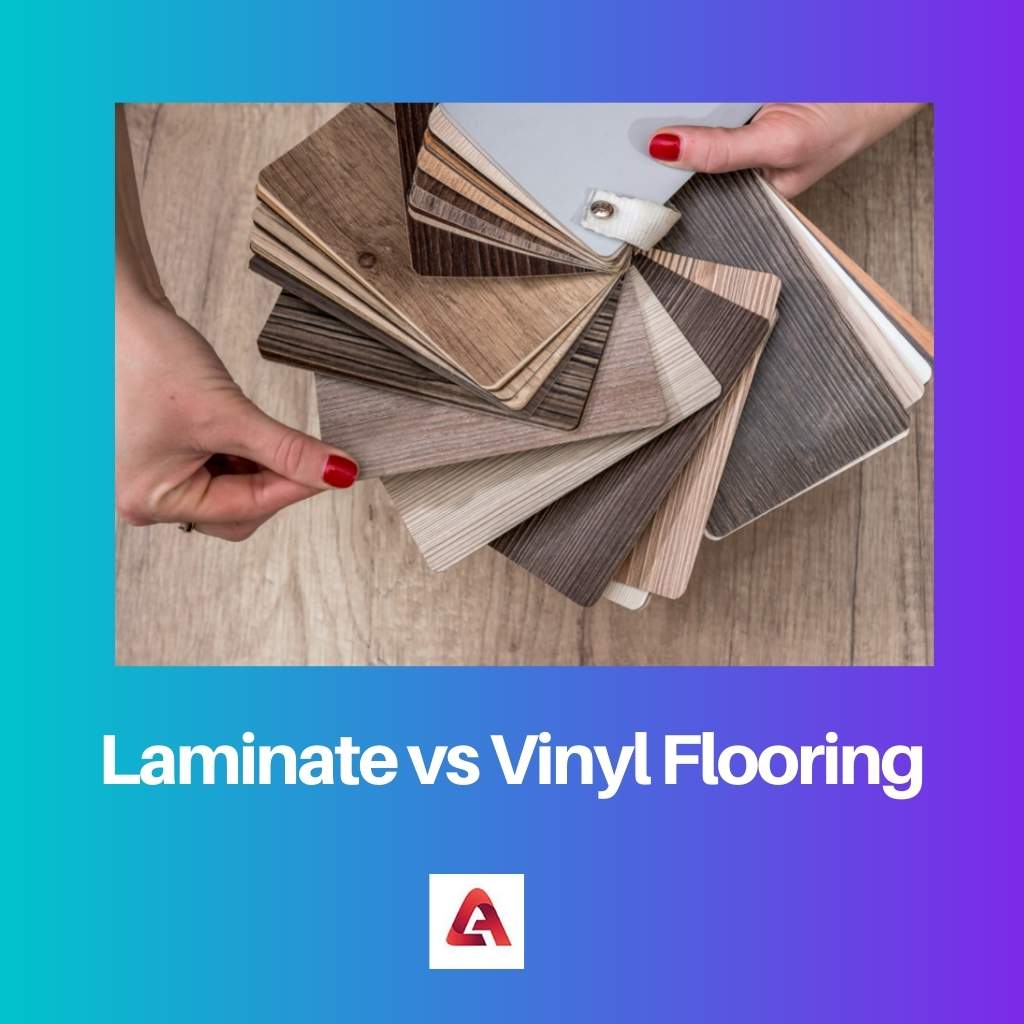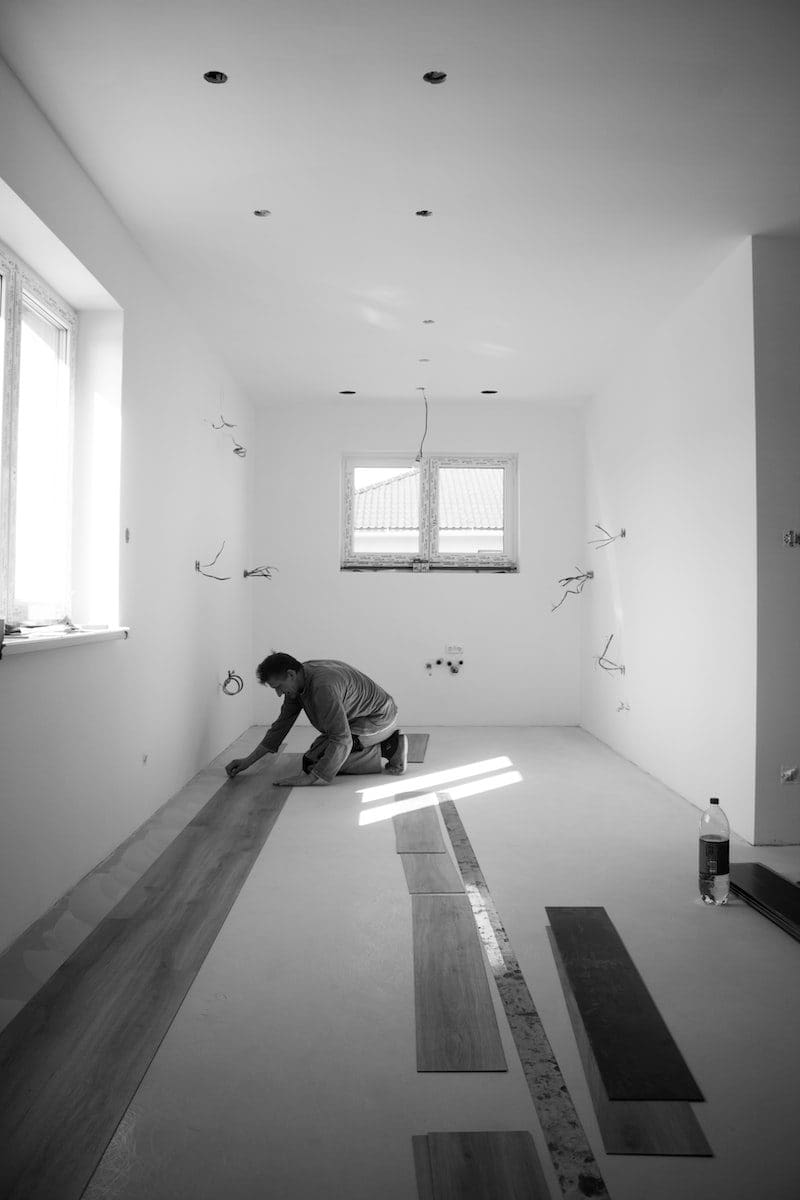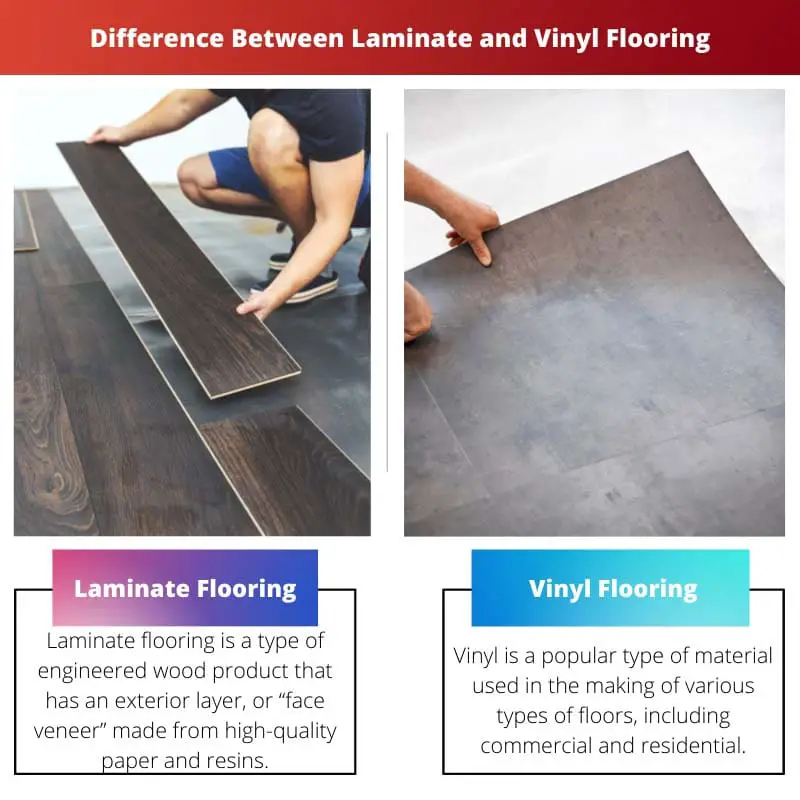One type is laminate, which is made from multiple layers of material that are glued together and can be installed over an existing hardwood or tile surface.
Vinyl, on the other hand, is made from a single layer that’s extruded in either sheet or plank form. Laminate floors are much more affordable than hardwood and can be installed with little to no professional assistance.
Key Takeaways
- Laminate flooring consists of a high-resolution image of wood or stone on a fiberboard core, while vinyl flooring is made from synthetic materials that mimic natural materials.
- Vinyl flooring is waterproof and suitable for areas exposed to moisture, while laminate flooring can be damaged by excessive water exposure.
- Laminate flooring offers a more realistic appearance and feel, while vinyl flooring is known for its durability and ease of maintenance.
Laminate vs Vinyl Flooring
Laminate flooring is made from a multi-layered synthetic material that is fused together with a lamination process. The top layer of laminate flooring is a durable, transparent wear layer. Vinyl flooring is made from a type of plastic called polyvinyl chloride (PVC). Vinyl flooring is available in two types: sheet vinyl and Vinyl flooring. They are made up of individual tiles.

A vinyl floor is made of durable, impact-resistant material. Vinyl floors are easy to clean and maintain with regular mopping or vacuuming.
They have an embossed pattern that gives them the look of wood planks or tiles without adding any weight to your home’s foundation. Vinyl floors come in many different colours, such as wood, tiles or granite and are lightweight.
It is important to note that Laminate floors require a slight amount of maintenance, but it’s worth the effort because they can be easily washed with water and soap without any harsh chemicals,
so you don’t have to worry about damaging your flooring. Vinyl floors, on the other hand, will last virtually forever as long as you do regular maintenance with the occasional mopping or vacuuming.
Comparison Table
| Parameters of Comparison | Laminate Flooring | Vinyl Flooring |
|---|---|---|
| Definition | Laminate flooring is a type of engineered wood product that has an exterior layer, or “face veneer” made from high-quality paper and resins. | Vinyl is a popular type of material used in the making of various types of floors, including commercial and residential. |
| Price | Laminate flooring is cheaper. | Vinyl flooring is expensive. |
| Durability | Laminate flooring will be less durable. Laminate tends to be a little thinner as well. | Vinyl is more scratchproof. |
| Appearance | Laminate flooring will have a more “wooden” appearance. | Vinyl is shinier and smoother to the touch. |
| Advantage | Laminate flooring is very durable and can be made to look like almost any type of wood, tile or stone. It also comes in many styles such as traditional, rustic, contemporary and more which means it will blend nicely into your home’s aesthetic design while covering up worn down areas. | Vinyl flooring is easy to install and maintain, which means it does not require a lot of time or effort for upkeep. When combined with other materials, such as tile, vinyl can also offer the same appearance that laminate can, like stone or wood, if you are looking for something different. |
What is Laminate Flooring?
Laminate is a type of flooring that has layers of plastic or paper and wood. These materials are printed with a design, which creates the appearance of natural hardwood without all the hassle!
Laminate stands up to wear better than other types of flooring (such as carpet) because it doesn’t need to be regularly shampooed or vacuumed.
It is easy to clean. Laminate is easy to clean and stands up well against dirt. It is eco-friendly, and laminate floors are created with recycled materials.
Durable: Laminate does not need to be replaced as because it has a protective topcoat that guards the floor against scratches, stains, and scuffs caused by foot traffic or spills!
It is affordable. Laminate is the least expensive type of flooring available.
Low maintenance: Laminates are low-maintenance because they do not need to be shampooed or vacuumed as and can’t hold odours like other types of floors may!
Laminate is not as durable as other materials and can crack or scratch easily. It will eventually wear out, but laminate does hold up better than carpeting in most cases!
It may be less comfortable to walk on because it is a harder material. Laminate flooring needs an underlayment of ¼ inch or more for insulation and sound control.

What is Vinyl Flooring?
Vinyl floors look like hardwood, tile or stone, but they’re not as expensive!
They do not show scratches so easily (especially in high-traffic areas) and can be used on stairs without showing signs of wear over time, unlike carpeted stairs. Vinyl is not a hard material to maintain.
You just need water and soap!
Vinyl floors are more comfortable to walk on than laminate because it bounces back like rubber, so your feet don’t hurt when walking over long distances or across wood flooring.
There are no seams in vinyl which mean fewer places for dust mites to hide and allergies to form.
Vinyl flooring is a type of homogeneous material that looks like natural wood, stone or ceramic tile but can be installed over just about any surface, including concrete subfloors, plywood floors, or directly onto a concrete slab.
It comes in both sheet and plank formats, so you have plenty of choices when deciding which kind you want. Vinyl is one of the more durable flooring types, so it’s ideal for high-traffic areas in your home (such as hallways or kitchens).
Vinyl flooring is a type of synthetic material that can be installed in many different ways, including being glued down or laid over the top of existing floors.
The vinyl product contains no natural materials and is made out of polyvinyl chloride (PVC) resin. Vinyl flooring is made in a wide variety of colours and textures to suit any home’s needs.

Main Differences Between Laminate and Vinyl Flooring
- Laminate is a more affordable option and can last up to 15 years with little maintenance. Vinyl flooring, on the other hand, will require regular upkeep in order to maintain its appearance.
- A laminate is less resistant to wear and tear, while a vinyl finish provides greater resistance against scratches.
- Laminate floors are matte, while vinyl floors have a shiny, reflective surface.
- Laminate will require special cleaners to remove stains or spills from the surface. Vinyl flooring is more water-resistant and can withstand spills better than laminate floor.
- The vinyl’s finish allows it to be easily cleaned with soap and warm water, whereas you’ll need specific products for a laminate floor.

- https://www.sciencedirect.com/science/article/pii/S0360132300000913
- https://www.sciencedirect.com/science/article/pii/S1352231001001753

This article provides a comprehensive understanding of the two types of flooring – laminate and vinyl. It’s a helpful guide for anyone considering these options for their homes.
The article effectively discusses the various considerations when choosing between laminate and vinyl flooring, providing valuable information to guide decision-making for homeowners.
The article offers a clear distinction between laminate and vinyl flooring, making it easier for readers to understand the characteristics and benefits of each type. Well-explained!
The information about the advantages and disadvantages of laminate and vinyl flooring is presented in a very informative manner. It’s a great resource for those considering these options for their homes.
Great comparison between laminate and vinyl flooring. Really helpful to know the difference between the two, especially in terms of price and durability.
The article effectively highlights the features and qualities of both laminate and vinyl flooring. It’s a valuable discussion for anyone interested in making an informed choice between the two types of flooring.
The details about the differences in appearance, durability, and maintenance requirements of laminate and vinyl flooring are very informative. This article provides a great deal of insight into the distinct characteristics of each type.
Very informative article. I appreciate the detailed comparison between laminate and vinyl flooring, which will help in making an informed decision when choosing flooring options.
The detailed comparison table is particularly useful. It effectively summarizes the main differences between laminate and vinyl flooring, making it easier to make an informed decision.
This article is a great resource for anyone in need of a thorough comparison between laminate and vinyl flooring. The information provided is highly informative and well-structured.